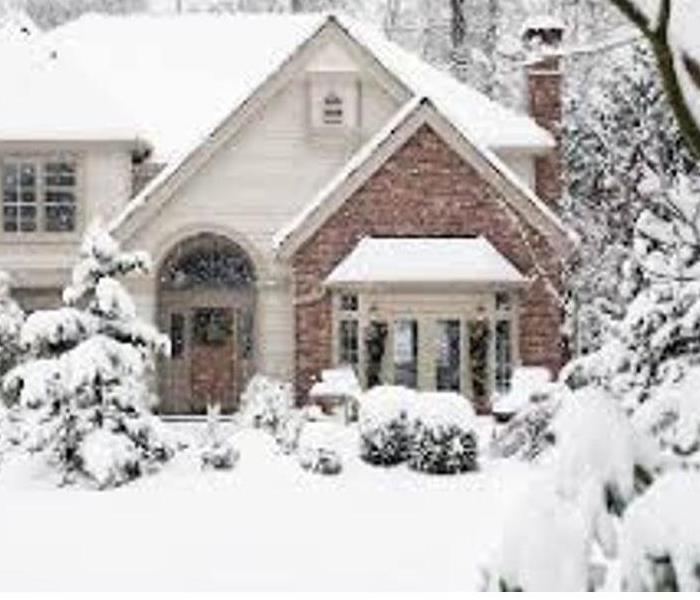Steps to Handle Winter Storm Damage
1/11/2022 (Permalink)
 The most common types of property damage caused by severe winter weather are roof damage or collapse due to snow, ice or sleet, and water damage from
The most common types of property damage caused by severe winter weather are roof damage or collapse due to snow, ice or sleet, and water damage from
Common Types of Winter Storm Damage You Might Face
It’s easy to imagine getting snowed in or having to deal with slippery surfaces due to ice, but there are actually many potential emergencies caused by winter storms. It’s a good idea to know some common disasters you might be up against before a storm arrives.
- Flooding — Cold snaps and freezes can damage pipes and cause them to burst, leading to water damage and flooded areas that need emergency restoration.
- Fires — Whether it’s due to unattended fireplaces, improperly cleaned chimneys, or space heaters plugged into overloaded outlets or left too near flammable objects, fires can often happen during a winter storm.
- Roof leaks — Frozen ice that melts, ice dams that block drainage pipes, heavy snow and ice breaking through shingles, hail strikes, and even high winds from winter storms can all be harsh on your roof, leaving your property exposed to moisture damage.
What to Do if Your Property Is Damaged
Once a winter storm strikes, your property can be left facing a number of things that need fixing fast. And if you don’t know what to do next, the situation can feel overwhelming. To help you get quick, effective storm restoration for your commercial and personal property, here’s a list of 7 immediate actions to take when you’re facing a storm-related disaster.
1. Stay calm.
It’s tempting and natural to freak out when an emergency arises. But do what you can to take a few deep breaths, so you can think straight. It’s important to make good decisions. So, while you may need to quickly act to put out the immediate fires, so to speak, you also owe it to yourself to take your time with the decisions that need careful assessment.
2. Ensure everyone’s safety
When your property has suffered damage, it may put people on the premises at risk. So, be sure your family, guests, clients, and employees are safe. Move everyone out of any areas that are affected. Do a headcount to make sure you know where everyone is. If the property is unsafe, you may need to arrange for a temporary place for the family to stay or for employees to work while the property is fixed.
3. Turn off power and water to affected areas
Often, winter storms can lead to leaks or floods from damaged roofs or burst pipes. Keeping the water running may make flooding worse while leaving electricity flowing could lead to a fire that compounds the damage. So, know where cutoff valves and breakers are located. Shut off the flow to damaged areas, and call utility companies if you need their assistance.
4. Document any losses
As soon as you can, make detailed notes of anything that is affected by the storm damage. This might include everything from furniture and business equipment to personal documents, valuables, and more. This list will be useful in making insurance claims and obtaining replacements to help get you back on your feet fast. Take photos of everything too, especially before anything is done to fix problems. This is essential for the insurance claim process.
5. Contact your insurance company
Once the immediate danger is passed — the storm is over, the fire is out, the flooding is contained, etc. — then it’s time to reach out to your insurance company. Call your agent to get the process of filing a claim started. Ask what you will need to provide (documents, photos, etc.) to back up the claim. Leave everything in place, except for what must be moved for safety, until the adjuster comes to document what happened.
6. Remove property from damaged areas
As soon as you have documented the damage, you’ll want to move property out of the danger zone quickly to minimize further damage. Valuables and important papers take the first precedence, because they may be impossible or very difficult to replace. After that, move items that you’d like to save but that can be replaced, such as furniture and electronics. Keep in mind that a restoration company can often help restore these items as well as the building itself.
7. Keep all receipts and documentation
Once the storm restoration process begins, you’ll end up with a lot of paperwork. Hold onto everything — photos, lists, videos, estimates, invoices, claim forms, receipts, etc. Put it all in one file for safekeeping. Consider creating an electronic file for this information in a cloud storage account so you can access it from anywhere. SERVPRO of Kendall County will assist you with all your needs along the way.





 24/7 Emergency Service
24/7 Emergency Service